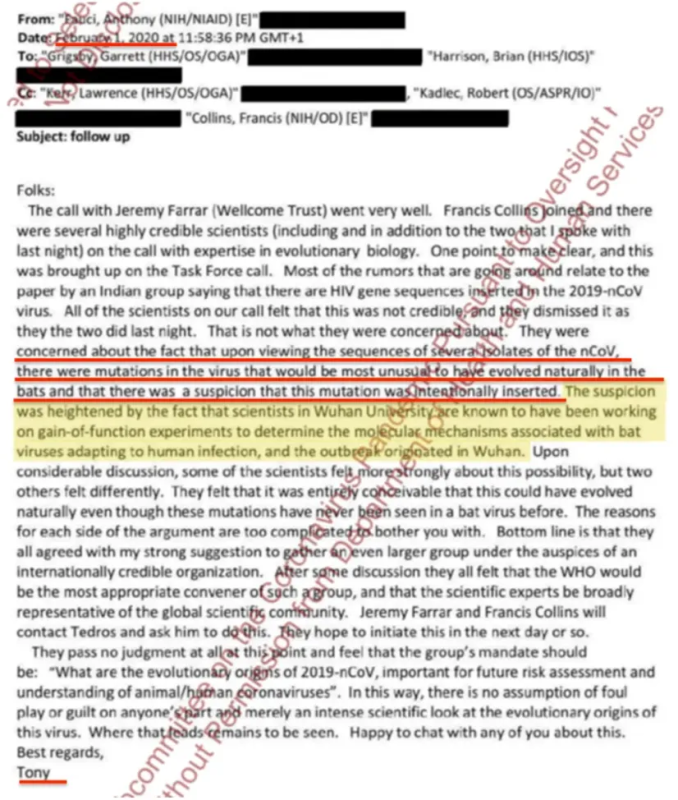
The Covid pandemic created some of the worst science writing in our lifetimes. Major media outlets failed at providing readers with accurate and balanced news across a host of issues, including vaccines, masks, lockdowns and how the virus likely began spreading through the human population.
It’s critical to call the news we read over the last four years “science writing” and not “reporting” because few science media outlets do any actual reporting. What science writers label “reporting’ is just calling up the known experts and then quoting them as the known experts.
As I’ve noted in the past: Science writers report for, not on science.
Looking back over the last four years of science writing claptrap, I ran across an early article by Science Magazine writer Jon Cohen that illustrates this point quite nicely. On January 31, 2020, Cohen wrote a story alleging that “most researchers say” the virus could not have come from a lab, an idea Cohen added, had been dismissed as a “conspiracy theory.”
However, Cohen’s “most researchers say” assertion was totally phony. How do we know this?
We have the emails.
“[S]ome of the features (potentially) look engineered,” a virologist wrote in a private email, the day after Cohen quoted him in his “most researchers say” article for Science Magazine.
That same day after Science Magazine published Cohen’s article—this would be February 1, 2020—Anthony Fauci emailed NIH officials detailing what “most researchers say” when they were talking to him on a conference call: they fretted that the virus was not natural, might have had a mutation inserted into the sequence, and their fears were heightened because scientists in Wuhan were running dangerous gain-of-function studies on coronaviruses.
Since Cohen wrote that January 2020 article, he has only doubled and tripled down with further allegations that the virus could not have escaped from a Wuhan lab.
As Ashley Rindsberg reported in Tablet, an anonymous whistleblower tipped off Cohen that one of the critical papers virologists published to allege the pandemic could not have started in a lab was apparently corrupt and did not list the true authors (Treason of the Science Journals). Instead of doing anything with the information, Cohen dimed out the whistleblower and forwarded the allegations on to the virologists: “Here’s what one person who claims to have inside knowledge is saying behind your backs…”
After this story went public, several accounts on X began referring to the Science Magazine staff writer as “Crooked Cohen” a label that eventually forced him off the social media app.
Cohen’s ham-fisted, biased attempt at journalism, however, remains a singular example of pandemic science writing gone awry. So let’s take a look at that early article he wrote.
Emails: The Bane of Science Writers
In the pandemic’s opening weeks, reporters scrambled to understand how the virus first began circulating in humans. Most outbreaks start when a virus, circulating in animals, adapts to the human body and then spreads to infect the rest of us. But the Washington Post reported in January 2020 that people were speculating on social media whether the pandemic started naturally or not.
Based on emails, we now know that some scientists were even concerned whether the virus came from a Wuhan lab.
But on January 31, 2020, Science Magazine’s Jon Cohen tried to shoot down such thinking in a misleading feature that ignored scientists’ own opinions. (Mining coronavirus genomes for clues to the outbreak’s origins: Theories abound about how the virus that’s now rampant in China made its way from bats (almost certainly) to humans.)
Here’s the second paragraph of Cohen’s story:
“One of the biggest takeaway messages [from the viral sequences] is that there was a single introduction into humans and then human-to-human spread,” says Trevor Bedford, a bioinformatics specialist at the University of Washington and Fred Hutchinson Cancer Research Center. The role of Huanan Seafood Wholesale Market in Wuhan, China, in spreading 2019-nCoV remains murky, though such sequencing, combined with sampling the market’s environment for the presence of the virus, is clarifying that it indeed had an important early role in amplifying the outbreak. The viral sequences, most researchers say, also knock down the idea the pathogen came from a virology institute in Wuhan.
Note three allegations in this paragraph:
- The virus entered the human population and then began spreading.
- The Huanan Seafood Market is critical.
- “Most researchers say” the virus sequences serve to “knock down” the idea that the virus came from a Wuhan lab.
Cohen also quotes two researchers: Kristian Andersen with Scripps Research, and Eddie Holmes with the University of Sydney.
The paragraph with Andersen serves to further enforce the idea that the virus didn’t come from a lab, and jumped from a wild animal (natural host) into humans.
“Until you consistently isolate the virus out of a single species, it’s really, really difficult to try and determine what the natural host is,” says Kristian Andersen, an evolutionary biologist at Scripps Research.
The paragraph quoting Eddie Holmes serves the same purpose: further enforcing the notion that the virus wasn’t engineered and didn’t come from a lab, but jumped from a wild animal into humans.
“The positive tests from the wet market are hugely important,” says Edward Holmes, an evolutionary biologist at the University of Sydney who collaborated with the first group to publicly release a 2019-nCoV sequence. “Such a high rate of positive tests would strongly imply that animals in the market played a key role in the emergence of the virus.”
In case the narrative wasn’t already clear, Cohen then addressed “conspiracy theories” about the pandemic beginning from lab research.
The Wuhan Institute of Virology, which is the premier lab in China that studies bat and human coronaviruses, has also come under fire. “Experts debunk fringe theory linking China’s coronavirus to weapons research,” read a headline on a story in The Washington Post that focused on the facility.
Well, here’s the funny thing. Emails show that Cohen’s “reporting” was totally wrong-headed.
The day after Cohen published his “most researchers say” piece to “knock down” the “conspiracy theory” that the virus could have come from a lab, Kristian Andersen—the same one quoted in Cohen’s story!—emailed Anthony Fauci.
“[S]ome of the features (potentially) look engineered,” Andersen wrote to Fauci. “Eddie Bob, Mike, and myself all find the genome inconsistent with expectations from evolutionary theory.
The Eddie, Bob, and Mike are researchers Eddie Holmes (who Cohen quoted in his “most researcher say” story), Bob Garry (a virologist at Tulane Medical School) and Michael Worobey (evolutionary biologist at the University of Arizona).
Yet none of Eddie, Bob, and Mike’s concerns that the Covid virus was engineered can be found in Cohen’s “most researchers say” article. Even though Cohen quotes Kristian Andersen and Eddie Holmes in the piece.
Oh, but it gets better.
Fauci responds to Andersen’s email, “Thanks, Kristian. Talk soon on the call.”
According to an email sent to Fauci by Jeremey Farrar of the Wellcome Trust, attendees on the call were to include Kristian Andersen, Eddie Holmes, and Bob Garry, as well as the following:
- Christian Drosten, Director of the Institute of Virology at the Charité Hospital in Berlin
- Ron Fouchier, Deputy Head of the Erasmus MC department of Viroscience
- Marion Koopmans, Dutch virologist who is Head of the Erasmus MC Department of Viroscience
- Patrick Valance, Chief Scientific Adviser to the Government of the United Kingdom
In short, the conference call attendees were a collection of experts that any reporter would call if they were going to write a “most researchers say” article about how the pandemic started.
Well, guess what?
After that call ended, Fauci sent an email detailing what he learned “most researchers say,” noting that NIH-Director Francis Collins was also listening in. Here’s Fauci:
They were concerned about the fact that upon viewing the sequences of several isolates of the nCoV, there were mutations in the virus that would be most unusual to have evolved naturally in the bats and there was a suspicion that this mutation was intentionally inserted. The suspicion was heightened by the fact that scientists in Wuhan University are known to have been working on gain-of-function experiments to determine the molecular mechanisms associated with bat viruses adapting to human infection, and the outbreak originated in Wuhan.
In short, here’s what “most researchers say” when their thoughts are not being stage-managed by Jon Cohen and the editors at Science Magazine:
- Mutations in the Covid virus do not appear to be natural;
- There was suspicion that a mutation was inserted into the virus;
- These suspicions were heightened because Wuhan scientists were doing dangerous gain-of-function research and the outbreak began in Wuhan.
Of course, only Jon Cohen knows why his “most researchers say” reporting was so phony and misguided.
I sent him an email asking him to explain, and got back an angry retort that ran over 800 words. Here’s one pertinent passage: “Andersen and Fauci did not share these concerns with me at the time, and if they had—and I wish they had—I certainly would have quoted them saying as much.”
“Jon, you seem upset,” I replied. “If Andersen and Fauci didn’t tell you what they were thinking, why are you directing anger at me? Have you asked them why they misled you? How are you going to hold them accountable to readers?”
Jon emailed back that I was twisting his words.
To this day, a majority of American remain concerned that the Covid pandemic started because scientists were screwing around in a lab with dangerous viruses and something went haywire. And these suspicions remain because virologists worked to gaslight anyone who raised this as a possibility—a propaganda campaign that was aided by their friends in science writing.
Republished from the author’s Substack
Source RSS Feed
RSS Feed















 March 13th, 2024
March 13th, 2024  Awake Goy
Awake Goy 

 Posted in
Posted in  Tags:
Tags: 













